
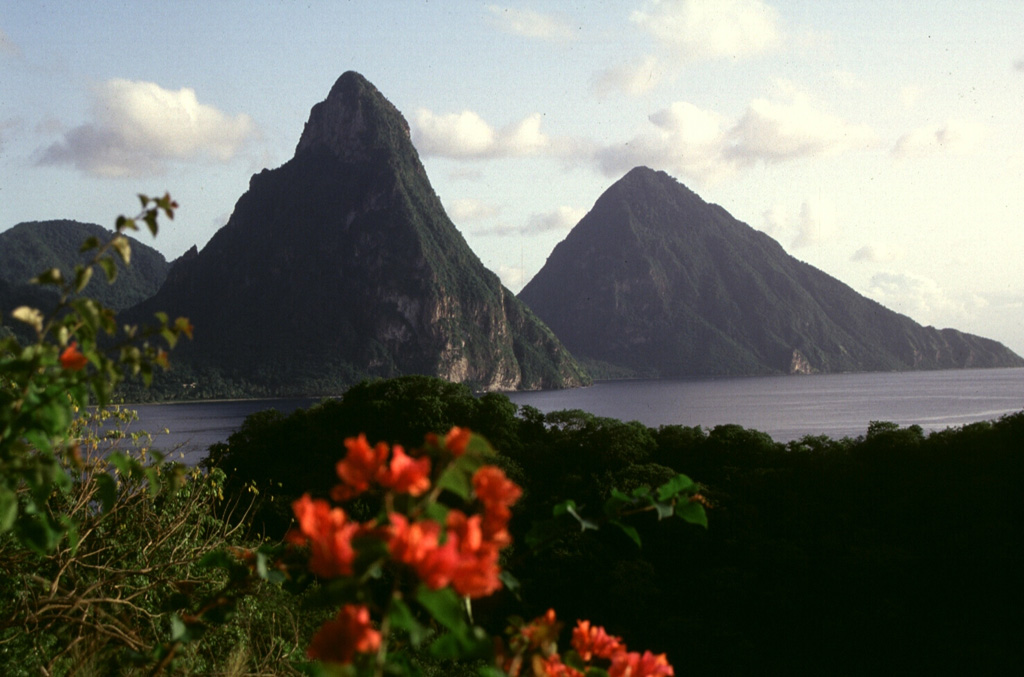
Apparent volcanic earthquakes clustered about 6 km ESE of Qualibou Caldera
"Since 17 May 1990, seismic stations in St. Lucia have been registering local earthquakes that appear to be of volcanic origin (both A- and B-type events were observed). About 172 events were detected by seismic station SLB (figure 1) from 17 May to 10 June, with peak activity occurring on 19 and 20 May (figure 2).
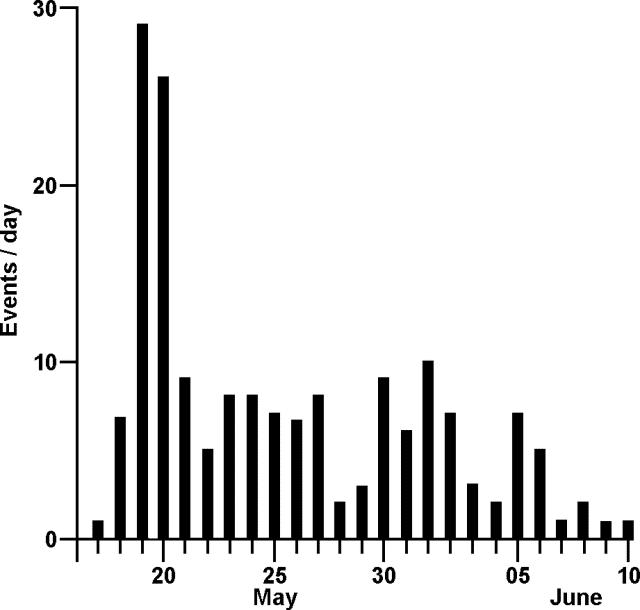 |
Figure 2. Number of seismic events/day recorded by station SLB on St. Lucia, 17 May-10 June 1990. Courtesy of the Seismic Research Unit, UWI. |
"Hypocentral parameters calculated for 34 well-recorded earthquakes show that events were predominantly clustered ~6 km ESE of Qualibou caldera, near Mt. Victorin (altitude 265 m). Focal depths were in the 10-20 km range and magnitudes were generally <mb 2.5. The largest event, of mb 4.6, occurred on 19 May at 1344 and was widely felt throughout St. Lucia. Two other events had magnitudes between 3.0 and 4.0 and were also felt.
"This is the first significant earthquake series that has occurred in St. Lucia since the establishment of a seismic station on the island in 1953, and does not appear to be a foreshock-mainshock- aftershock sequence. The cause of the seismicity is still uncertain but may be due to the intrusion of a small magma body. Temperatures of hot springs in Qualibou caldera did not exhibit any significant variation during the main period of the activity and no episodes of harmonic tremor were recorded."
Information Contacts: W. Ambeh, K. Rowley, L. Lynch, and L. Pollard, UWI.
The Global Volcanism Program has no Weekly Reports available for Qualibou.
Reports are organized chronologically and indexed below by Month/Year (Publication Volume:Number), and include a one-line summary. Click on the index link or scroll down to read the reports.
Apparent volcanic earthquakes clustered about 6 km ESE of Qualibou Caldera
"Since 17 May 1990, seismic stations in St. Lucia have been registering local earthquakes that appear to be of volcanic origin (both A- and B-type events were observed). About 172 events were detected by seismic station SLB (figure 1) from 17 May to 10 June, with peak activity occurring on 19 and 20 May (figure 2).
 |
Figure 2. Number of seismic events/day recorded by station SLB on St. Lucia, 17 May-10 June 1990. Courtesy of the Seismic Research Unit, UWI. |
"Hypocentral parameters calculated for 34 well-recorded earthquakes show that events were predominantly clustered ~6 km ESE of Qualibou caldera, near Mt. Victorin (altitude 265 m). Focal depths were in the 10-20 km range and magnitudes were generally <mb 2.5. The largest event, of mb 4.6, occurred on 19 May at 1344 and was widely felt throughout St. Lucia. Two other events had magnitudes between 3.0 and 4.0 and were also felt.
"This is the first significant earthquake series that has occurred in St. Lucia since the establishment of a seismic station on the island in 1953, and does not appear to be a foreshock-mainshock- aftershock sequence. The cause of the seismicity is still uncertain but may be due to the intrusion of a small magma body. Temperatures of hot springs in Qualibou caldera did not exhibit any significant variation during the main period of the activity and no episodes of harmonic tremor were recorded."
Information Contacts: W. Ambeh, K. Rowley, L. Lynch, and L. Pollard, UWI.
|
|
||||||||||||||||||||||||||||
There is data available for 1 confirmed eruptive period.
1766 Confirmed Eruption (Explosive / Effusive) VEI: 1
| Episode 1 | Eruption (Explosive / Effusive) | Sulphur Springs area | |||||||||||||||||||||||
|---|---|---|---|---|---|---|---|---|---|---|---|---|---|---|---|---|---|---|---|---|---|---|---|---|
| 1766 - Unknown | Evidence from Observations: Reported | |||||||||||||||||||||||
|
List of 3 Events for Episode 1 at Sulphur Springs area
|
||||||||||||||||||||||||
This compilation of synonyms and subsidiary features may not be comprehensive. Features are organized into four major categories: Cones, Craters, Domes, and Thermal Features. Synonyms of features appear indented below the primary name. In some cases additional feature type, elevation, or location details are provided.
Synonyms |
||||
| Soufrière Volcanic Centre | ||||
Cones |
||||
| Feature Name | Feature Type | Elevation | Latitude | Longitude |
| Fond Doux | Cone | 507 m | 13° 49' 0.00" N | 61° 3' 0.00" W |
| Gimie, Mount | Stratovolcano | 950 m | 13° 52' 0.00" N | 61° 1' 0.00" W |
| Sulphur Springs | Vent | 240 m | 13° 50' 0.00" N | 61° 3' 0.00" W |
| Tabac, Mount | Stratovolcano | 678 m | 13° 52' 0.00" N | 61° 3' 0.00" W |
Craters |
||||
| Feature Name | Feature Type | Elevation | Latitude | Longitude |
| Dauphine Estate, La | Crater | 320 m | 13° 49' 0.00" N | 61° 3' 0.00" W |
Domes |
||||
| Feature Name | Feature Type | Elevation | Latitude | Longitude |
| Belfond | Dome | 500 m | 13° 49' 0.00" N | 61° 2' 0.00" W |
| Bois d'Inde Franciou | Dome | 335 m | 13° 48' 0.00" N | 61° 3' 0.00" W |
| Bonin, Morne | Dome | 670 m | 13° 50' 0.00" N | 61° 2' 0.00" W |
| Gros Piton | Dome | 777 m | 13° 49' 0.00" N | 61° 4' 0.00" W |
| Malgretoute | Dome | 363 m | 13° 50' 0.00" N | 61° 3' 0.00" W |
| Petit Piton | Dome | 743 m | 13° 48' 0.00" N | 61° 4' 0.00" W |
| Plaisance | Dome | 500 m | 13° 49' 0.00" N | 61° 3' 0.00" W |
| Rabot | Dome | 380 m | 13° 50' 0.00" N | 61° 3' 0.00" W |
| Terre Blanche | Dome | 580 m | 13° 50' 0.00" N | 61° 2' 0.00" W |
Thermal |
||||
| Feature Name | Feature Type | Elevation | Latitude | Longitude |
| Sulphur Springs | Hot Spring | |||
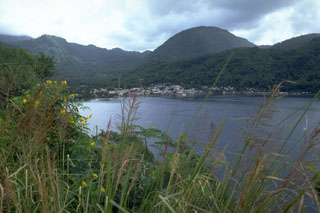 The town of Soufriere lies just NW of the 10-km-wide Qualibou caldera. This view from the NW looks across Soufriere Bay to the rounded Terre Blanche lava dome. The western caldera wall lies between the dome and the gentle ridge behind the town. The ridge in the background to the left of Terre Blanche is the back wall of the 3.5 x 5 km caldera, which was formed during powerful eruptions about 32-39,000 years ago.
The town of Soufriere lies just NW of the 10-km-wide Qualibou caldera. This view from the NW looks across Soufriere Bay to the rounded Terre Blanche lava dome. The western caldera wall lies between the dome and the gentle ridge behind the town. The ridge in the background to the left of Terre Blanche is the back wall of the 3.5 x 5 km caldera, which was formed during powerful eruptions about 32-39,000 years ago.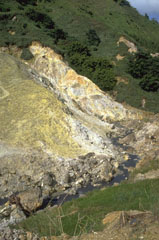 Hydrothermally altered rocks are exposed over a wide area in the Sulphur Springs thermal area of Qualibou volcano. The thermal area, located in a valley SW of Terre Blanche lava dome, contains 11 hot pools, some of which occasionally produce small steam-driven fountains about 1-m high. Sulphur Springs was the site in 1766 of the only historical eruption of Qualibou. A small explosion deposited ash and cinders over a wide area.
Hydrothermally altered rocks are exposed over a wide area in the Sulphur Springs thermal area of Qualibou volcano. The thermal area, located in a valley SW of Terre Blanche lava dome, contains 11 hot pools, some of which occasionally produce small steam-driven fountains about 1-m high. Sulphur Springs was the site in 1766 of the only historical eruption of Qualibou. A small explosion deposited ash and cinders over a wide area.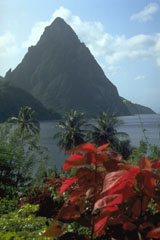 The steep-sided pyramid of the Petit Piton lava dome, the northernmost of St. Lucia's renowned Pitons, rises to the south above Soufriere Bay. The dramatic peak is the eroded plug of a dacitic dome that was emplaced about 250,000 years ago. The 743-m-high dome displays nearly vertical flow banding on all sides. Emplacement of the Pitons preceded formation of the Qualibou caldera about 32-39,000 years ago.
The steep-sided pyramid of the Petit Piton lava dome, the northernmost of St. Lucia's renowned Pitons, rises to the south above Soufriere Bay. The dramatic peak is the eroded plug of a dacitic dome that was emplaced about 250,000 years ago. The 743-m-high dome displays nearly vertical flow banding on all sides. Emplacement of the Pitons preceded formation of the Qualibou caldera about 32-39,000 years ago.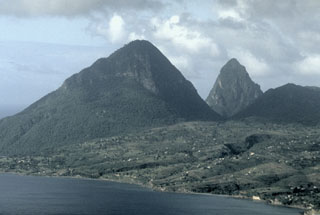 The Pitons, the dramatic landmarks of the island of St. Lucia, are the eroded plugs of two Pleistocene lava domes. Gros Piton (left) and the even steeper Petit Piton (right) are pre-caldera lava domes west and SW of the late-Pleistocene Qualibou caldera. The lower ridge in the right foreground is the SW-most of the 3 Bois d'Indie Franciou andesitic lava domes. They were constructed along a NE-trending fault.
The Pitons, the dramatic landmarks of the island of St. Lucia, are the eroded plugs of two Pleistocene lava domes. Gros Piton (left) and the even steeper Petit Piton (right) are pre-caldera lava domes west and SW of the late-Pleistocene Qualibou caldera. The lower ridge in the right foreground is the SW-most of the 3 Bois d'Indie Franciou andesitic lava domes. They were constructed along a NE-trending fault.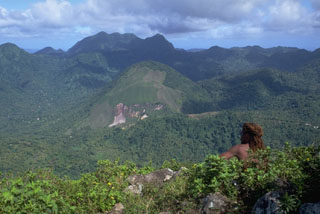 The rounded Terre Blanche lava dome (center) was constructed within the 3.5 x 5 km wide Qualibou caldera. The dome is seen here from the summit of Petit Piton, a pre-caldera lava dome, with the skyline ridge forming the NE caldera wall. Andesitic lava flows and breccias are exposed in the caldera wall. The 450-m-high Terre Blanche dome is one of 3 dacitic lava domes that grew following formation of the caldera about 39,000 years ago.
The rounded Terre Blanche lava dome (center) was constructed within the 3.5 x 5 km wide Qualibou caldera. The dome is seen here from the summit of Petit Piton, a pre-caldera lava dome, with the skyline ridge forming the NE caldera wall. Andesitic lava flows and breccias are exposed in the caldera wall. The 450-m-high Terre Blanche dome is one of 3 dacitic lava domes that grew following formation of the caldera about 39,000 years ago.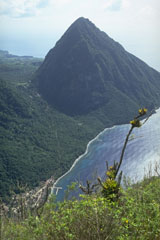 Gros Piton, seen here from the summit of the Petit Piton, is the southernmost of the twin lava domes that are the hallmark of the island of St. Lucia. The 777-m high and 3-km wide dacitic dome was erupted about 260,000 years ago. Rocks of a small tuff ring are exposed at its base.
Gros Piton, seen here from the summit of the Petit Piton, is the southernmost of the twin lava domes that are the hallmark of the island of St. Lucia. The 777-m high and 3-km wide dacitic dome was erupted about 260,000 years ago. Rocks of a small tuff ring are exposed at its base. The twin lava domes of the Pitons rise above Soufriere Bay on St. Lucia, forming one of the scenic highlights of the West Indies. Petit Piton (left) and Gros Piton (right) are the eroded plugs of 250,000-year-old dacitic lava domes preceding formation of the 3.5 x 5 km Qualibou caldera about 32-39,000 years ago. The only known Holocene activity at Qualibou was a minor phreatic eruption in the Sulfur Springs thermal area in 1766 CE that ejected a thin ash layer over a wide area.
The twin lava domes of the Pitons rise above Soufriere Bay on St. Lucia, forming one of the scenic highlights of the West Indies. Petit Piton (left) and Gros Piton (right) are the eroded plugs of 250,000-year-old dacitic lava domes preceding formation of the 3.5 x 5 km Qualibou caldera about 32-39,000 years ago. The only known Holocene activity at Qualibou was a minor phreatic eruption in the Sulfur Springs thermal area in 1766 CE that ejected a thin ash layer over a wide area. There are no samples for Qualibou in the Smithsonian's NMNH Department of Mineral Sciences Rock and Ore collection.
| Copernicus Browser | The Copernicus Browser replaced the Sentinel Hub Playground browser in 2023, to provide access to Earth observation archives from the Copernicus Data Space Ecosystem, the main distribution platform for data from the EU Copernicus missions. |
| MIROVA | Middle InfraRed Observation of Volcanic Activity (MIROVA) is a near real time volcanic hot-spot detection system based on the analysis of MODIS (Moderate Resolution Imaging Spectroradiometer) data. In particular, MIROVA uses the Middle InfraRed Radiation (MIR), measured over target volcanoes, in order to detect, locate and measure the heat radiation sourced from volcanic activity. |
| MODVOLC Thermal Alerts | Using infrared satellite Moderate Resolution Imaging Spectroradiometer (MODIS) data, scientists at the Hawai'i Institute of Geophysics and Planetology, University of Hawai'i, developed an automated system called MODVOLC to map thermal hot-spots in near real time. For each MODIS image, the algorithm automatically scans each 1 km pixel within it to check for high-temperature hot-spots. When one is found the date, time, location, and intensity are recorded. MODIS looks at every square km of the Earth every 48 hours, once during the day and once during the night, and the presence of two MODIS sensors in space allows at least four hot-spot observations every two days. Each day updated global maps are compiled to display the locations of all hot spots detected in the previous 24 hours. There is a drop-down list with volcano names which allow users to 'zoom-in' and examine the distribution of hot-spots at a variety of spatial scales. |
|
WOVOdat
Single Volcano View Temporal Evolution of Unrest Side by Side Volcanoes |
WOVOdat is a database of volcanic unrest; instrumentally and visually recorded changes in seismicity, ground deformation, gas emission, and other parameters from their normal baselines. It is sponsored by the World Organization of Volcano Observatories (WOVO) and presently hosted at the Earth Observatory of Singapore.
GVMID Data on Volcano Monitoring Infrastructure The Global Volcano Monitoring Infrastructure Database GVMID, is aimed at documenting and improving capabilities of volcano monitoring from the ground and space. GVMID should provide a snapshot and baseline view of the techniques and instrumentation that are in place at various volcanoes, which can be use by volcano observatories as reference to setup new monitoring system or improving networks at a specific volcano. These data will allow identification of what monitoring gaps exist, which can be then targeted by remote sensing infrastructure and future instrument deployments. |
| Volcanic Hazard Maps | The IAVCEI Commission on Volcanic Hazards and Risk has a Volcanic Hazard Maps database designed to serve as a resource for hazard mappers (or other interested parties) to explore how common issues in hazard map development have been addressed at different volcanoes, in different countries, for different hazards, and for different intended audiences. In addition to the comprehensive, searchable Volcanic Hazard Maps Database, this website contains information about diversity of volcanic hazard maps, illustrated using examples from the database. This site is for educational purposes related to volcanic hazard maps. Hazard maps found on this website should not be used for emergency purposes. For the most recent, official hazard map for a particular volcano, please seek out the proper institutional authorities on the matter. |
| IRIS seismic stations/networks | Incorporated Research Institutions for Seismology (IRIS) Data Services map showing the location of seismic stations from all available networks (permanent or temporary) within a radius of 0.18° (about 20 km at mid-latitudes) from the given location of Qualibou. Users can customize a variety of filters and options in the left panel. Note that if there are no stations are known the map will default to show the entire world with a "No data matched request" error notice. |
| UNAVCO GPS/GNSS stations | Geodetic Data Services map from UNAVCO showing the location of GPS/GNSS stations from all available networks (permanent or temporary) within a radius of 20 km from the given location of Qualibou. Users can customize the data search based on station or network names, location, and time window. Requires Adobe Flash Player. |
| DECADE Data | The DECADE portal, still in the developmental stage, serves as an example of the proposed interoperability between The Smithsonian Institution's Global Volcanism Program, the Mapping Gas Emissions (MaGa) Database, and the EarthChem Geochemical Portal. The Deep Earth Carbon Degassing (DECADE) initiative seeks to use new and established technologies to determine accurate global fluxes of volcanic CO2 to the atmosphere, but installing CO2 monitoring networks on 20 of the world's 150 most actively degassing volcanoes. The group uses related laboratory-based studies (direct gas sampling and analysis, melt inclusions) to provide new data for direct degassing of deep earth carbon to the atmosphere. |
| Large Eruptions of Qualibou | Information about large Quaternary eruptions (VEI >= 4) is cataloged in the Large Magnitude Explosive Volcanic Eruptions (LaMEVE) database of the Volcano Global Risk Identification and Analysis Project (VOGRIPA). |
| EarthChem | EarthChem develops and maintains databases, software, and services that support the preservation, discovery, access and analysis of geochemical data, and facilitate their integration with the broad array of other available earth science parameters. EarthChem is operated by a joint team of disciplinary scientists, data scientists, data managers and information technology developers who are part of the NSF-funded data facility Integrated Earth Data Applications (IEDA). IEDA is a collaborative effort of EarthChem and the Marine Geoscience Data System (MGDS). |